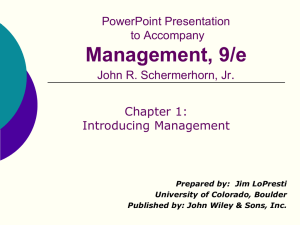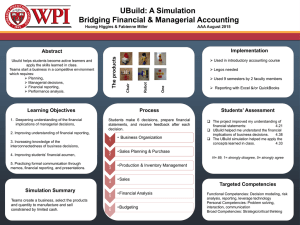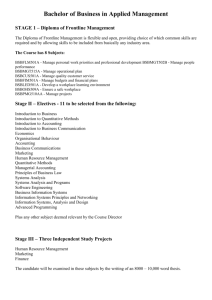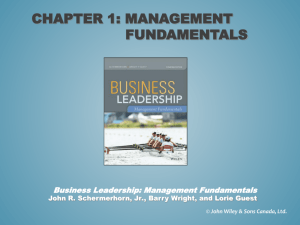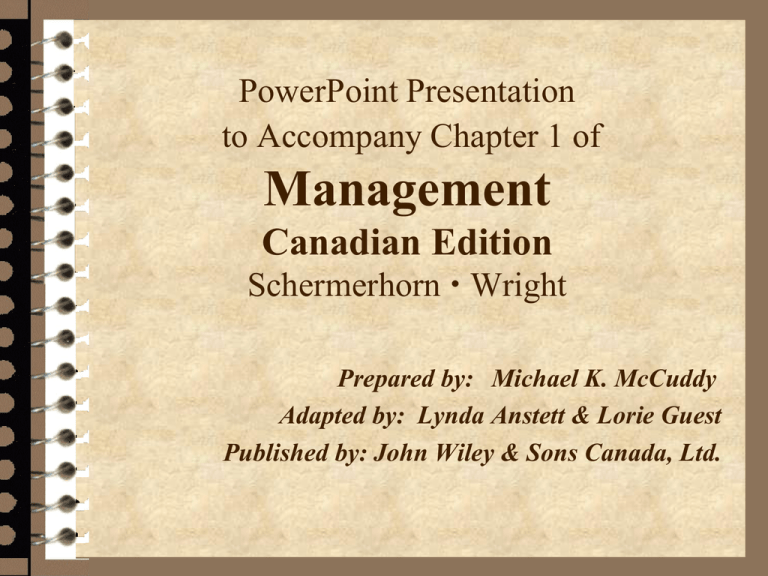
PowerPoint Presentation
to Accompany Chapter 1 of
Management
Canadian Edition
Schermerhorn Wright
Prepared by: Michael K. McCuddy
Adapted by: Lynda Anstett & Lorie Guest
Published by: John Wiley & Sons Canada, Ltd.
Planning Ahead — Chapter 1 Study Questions
What are the challenges of working in the
new economy?
What are organizations like in the new
workplace?
Who are managers and what do they do?
What is the management process?
How do you learn the essential managerial
skills and competencies?
Management - Chapter 1
2
Overview of the 21st century workplace
Organizations must adapt to rapidly
changing society.
Economy is global and driven by innovation
and technology.
High performing companies gain
extraordinary results from people working
for them.
Interdependent, knowledge based
Management - Chapter 1
3
Study Question 1: What are the challenges of
working in the new economy?
Intellectual capital
– People are the the ultimate foundations of
organizational performance.
– Intellectual capital is the collective brainpower
or shared knowledge of a workforce that can be
used to create value.
– A knowledge worker adds to the intellectual
capital of an organization.
Management - Chapter 1
4
Study Question 1: What are the challenges of
working in the new economy?
Globalization …
– National boundaries of world business have
largely disappeared.
– Globalization is the worldwide
interdependence of resource flows, product
markets, and business competition that
characterize the new economy.
Management - Chapter 1
5
Study Question 1: What are the challenges of
working in the new economy?
Technology …
– Continuing transformation of the modern
workplace through:
•
•
•
•
The Internet
World Wide Web
Computers
Information technology
– Increasing demand for knowledge workers with
the skills to fully utilize technology.
Management - Chapter 1
6
Study Question 1: What are the challenges of
working in the new economy?
Diversity …
– Workforce diversity reflects differences
with respect to gender, age, race,
ethnicity, religion, sexual orientation, and
able-bodiedness.
– A diverse and multicultural workforce
both challenges and offers opportunities
to employers.
Management - Chapter 1
7
Study Question 1: What are the challenges of
working in the new economy?
Ethics …
– Code of moral principles.
– Society requires businesses to operate
according to high moral standards.
– Emphasis today on restoring the strength
of corporate governance
Management - Chapter 1
8
Study Question 1: What are the challenges of
working in the new economy?
Careers …
– Career of 21st century won’t be uniformly
full-time and limited to a single large
employer
– Skills must be portable and always of
current value
Management - Chapter 1
9
Study Question 2: What are organizations like
in the new workplace?
Critical skills for success in the new
workplace …
–
–
–
–
–
–
Mastery
Contacts
Entrepreneurship
Love of technology
Marketing
Passion for renewal
Management - Chapter 1
10
Study Question 2: What are organizations like
in the new workplace?
Organization
– A collection of people working together to
achieve a common purpose.
– Organizations provide useful goods and/or
services that return value to society and satisfy
customer needs.
Management - Chapter 1
11
Study Question 2: What are organizations like
in the new workplace?
Organizations are open systems
– Composed of interrelated parts that function
together to achieve a common purpose.
– Interact with their environments.
– Transform resource inputs into product outputs
(goods and services).
– Environmental feedback tells organization how
well it is meeting the needs of customers and
society.
Management - Chapter 1
12
Figure 1.1 Organizations as open systems.
Management - Chapter 1
13
Study Question 2: What are organizations like
in the new workplace?
Organizational performance
– Value is created when an organization’s
operations adds value to the original cost of
resource inputs.
– When value creation occurs:
• Businesses earn a profit.
• Nonprofit organizations add wealth to society.
Management - Chapter 1
14
Study Question 2: What are organizations like
in the new workplace?
Organizational performance
– Productivity
• An overall measure of the quantity and quality of
work performance with resource utilization taken
into account.
– Performance effectiveness
• An output measure of task or goal accomplishment.
– Performance efficiency
• An input measure of the resource costs associated
with goal accomplishment.
Management - Chapter 1
15
Figure 1.2 Productivity and the
dimensions of organizational performance.
Management - Chapter 1
16
Study Question 2: What are organizations like
in the new workplace?
Workplace changes that provide a context for
studying management …
–
–
–
–
–
–
–
–
Belief in human capital
Demise of “command-and-control”
Emphasis on teamwork
Preeminence of technology
Embrace of networking
New workforce expectations
Concern for work-life balance
Focus on speed
Management - Chapter 1
17
Study Question 3: Who are managers and
what do they do?
Importance of human resources and
managers …
– “Toxic workplaces” treat employees as costs.
– High performing organizations treat people as
valuable strategic assets.
– Managers must ensure that people are treated as
strategic assets.
Management - Chapter 1
18
Study Question 3: Who are managers and
what do they do?
A manager is a person in an organization
who supports and is responsible for the work
of others.
The people who managers help are the ones
whose tasks represent the real work of the
organization.
Management - Chapter 1
19
Study Question 3: Who are managers and
what do they do?
Levels of management:
– Top managers — responsible for performance of an
organization as a whole or for one of its larger parts.
– Middle managers — in charge of relatively large
departments or divisions.
– Project managers __ coordinate complex projects with
task deadlines.
– Team leaders or supervisors — in charge of a small
work group of non-managerial workers.
Management - Chapter 1
20
Study Question 3: Who are managers and
what do they do?
Responsibilities of team leaders:
– Plan meetings and work schedules.
– Clarify goals and tasks, and gather ideas for
improvement.
– Appraise performance and counsel team
members.
– Recommend pay raises and new assignments.
– Recruit, develop, and train team members.
Management - Chapter 1
21
Study Question 3: Who are managers and
what do they do?
Responsibilities of team leaders (cont.):
– Encourage high performance and teamwork.
– Inform team members about organizational
goals and expectations.
– Inform higher levels of work unit needs and
accomplishments.
– Coordinate with others teams and support the
rest of the organization.
Management - Chapter 1
22
Study Question 3: Who are managers and
what do they do?
Types of managers
– Line managers are responsible for work activities that
directly affect organization’s outputs.
– Staff managers use technical expertise to advise and
support the efforts of line workers.
– Functional managers are responsible for a single area of
activity.
– General managers are responsible for more complex
units that include many functional areas.
– Administrators work in public and nonprofit
organizations.
Management - Chapter 1
23
Study Question 3: Who are managers and
what do they do?
Managerial performance and accountability
– Accountability is the requirement of one person
to answer to a higher authority for relevant
performance results.
– Effective managers fulfill performance
accountability by helping others to achieve high
performance outcomes and experience
satisfaction in their work.
Management - Chapter 1
24
Study Question 3: Who are managers and
what do they do?
Quality of work life (QWL)
– An indicator of the overall quality of human
experiences in the workplace.
– QWL indicators:
•
•
•
•
•
•
Fair pay
Safe working conditions
Opportunities to learn and use new skills
Room to grow and progress in a career
Protection of individual rights
Pride in work itself and in the organization
Management - Chapter 1
25
Study Question 3: Who are managers and
what do they do?
High performing managers …
– Build working relationships with others.
– Help others develop their skills and
performance competencies.
– Foster teamwork.
– Create a work environment that is performance-
driven and provides satisfaction for workers.
Management - Chapter 1
26
Study Question 3: Who are managers and
what do they do?
The organization as an upside-down
pyramid …
– Each individual is a value-added worker.
– A manager’s job is to support workers’ efforts.
– The best managers are known for helping and
supporting.
Management - Chapter 1
27
Figure 1.3 The organization viewed as an
upside-down pyramid.
Management - Chapter 1
28
Study Question 4: What is the
management process?
Management is the process of planning,
organizing, leading, and controlling the use
of resources to accomplish performance
goals.
All managers are responsible for the four
functions.
The functions are carried on continually.
Management - Chapter 1
29
Figure 1.4 Four functions of management.
Management - Chapter 1
30
Study Question 4: What is the
management process?
Functions of management …
– Planning
• The process of setting objectives and determining
what actions should be taken to accomplish them.
– Organizing
• The process of assigning tasks, allocating resources,
and arranging the coordinated activities of
individuals and groups to implement plans.
Management - Chapter 1
31
Study Question 4: What is the
management process?
Functions of management …
– Leading
• The process of arousing people’s enthusiasm to
work hard and direct their efforts to fulfill plans and
accomplish objectives.
– Controlling
• The process of measuring work performance,
comparing results to objectives, and taking
corrective action as needed.
Management - Chapter 1
32
Study Question 4: What is the
management process?
Managerial activities and roles …
– Interpersonal roles
• Involve interactions with persons inside and outside
the work unit.
– Informational roles
• Involve giving, receiving, and analyzing of
information.
– Decisional roles
• Involve using information to make decisions in
order to solve problems or address opportunities.
Management - Chapter 1
33
Figure 1.5 Mintzberg’s 10 managerial
roles.
Management - Chapter 1
34
Study Question 4: What is the
management process?
Characteristics of managerial work …
– Managers work long hours.
– Managers work at an intense pace.
– Managers work at fragmented and varied tasks.
– Managers work with many communication
media.
– Managers work largely through interpersonal
relationships.
Management - Chapter 1
35
Study Question 4: What is the
management process?
Managerial agendas and networks …
– Agenda setting
• Development of action priorities for one’s job.
• Include goals and plans that span long and short
time frames.
– Networking
• Process of building and maintaining positive
relationships with people whose help may be
needed to implement one’s work agendas.
Management - Chapter 1
36
Study Question 5: How do you learn the
essential managerial skills and competencies?
Essential managerial skills
– Skill — the ability to translate knowledge into action
that results in desired performance.
– Technical skill — the ability to apply a special
proficiency or expertise to perform particular tasks.
– Human skill — the ability to work well in cooperation
with others.
– Conceptual skill — the ability to think critically and
analytically to solve complex problems.
Management - Chapter 1
37
Figure 1.6 Katz’s essential managerial
skills.
Management - Chapter 1
38
Study Question 5: How do you learn the
essential managerial skills and competencies?
Managerial competency …
– A skill-based capability that contributes to high
performance in a management job.
– Managerial competencies are implicit in:
– Planning, organizing, leading, and controlling.
– Informational, interpersonal, and decisional
roles.
– Agenda setting and networking.
Management - Chapter 1
39
Study Question 5: How do you learn the
essential managerial skills and competencies?
Competencies for managerial success:
– Communication
– Teamwork
– Self-management
– Leadership
– Critical thinking
– Professionalism
Management - Chapter 1
40
Figure 1.7 Understanding Management
from Theory to Practice.
Management - Chapter 1
41
COPYRIGHT
Copyright © 2007 John Wiley & Sons Canada, Ltd. All rights
reserved. Reproduction or translation of this work beyond that
permitted by Access Copyright (The Canadian Copyright Licensing
Agency) is unlawful. Requests for further information should be
addressed to the Permissions Department, John Wiley & Sons
Canada, Ltd. The purchaser may make back-up copies for his or her
own use only and not for distribution or resale. The author and the
publisher assume no responsibility for errors, omissions, or damages
caused by the use of these programs or from the use of the
information contained herein.

